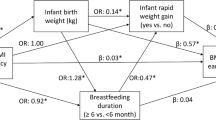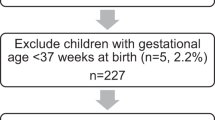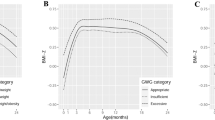Abstract
OBJECTIVE:
To describe different patterns of overweight status between ages 5 and 14 y and examine the role of modifiable family and early life characteristics in explaining different patterns of change between these two ages.
DESIGN:
A population-based prospective birth cohort.
SUBJECTS:
A total of 2934 children (52% males) who were participants in the Mater-University study of pregnancy, Brisbane, and who were examined at ages 5 and 14 y.
MAIN OUTCOME MEASURES:
Four patterns of change in overweight/obesity status between ages 5 and 14 y: (i) normal at both ages; (ii) normal at 5 y and overweight/obese at 14 y; (iii) overweight/obese at 5 y and normal at 14 y; (iv) overweight/obese at both ages.
RESULTS:
Of the 2934 participants, 2018 (68.8%) had a normal body mass index (BMI) at ages 5 and 14 y, 425 (14.5%) changed from a normal BMI at age 5 y to overweight or obese at age 14 y, 175 (6.0%) changed from being overweight or obese at age 5 y to normal weight at age 14 y and 316 (10.8%) were overweight or obese at both ages 5 and 14 y. Girls were more likely to make the transition from overweight or obese at age 5 y to normal at 14 y than their boy counterparts. Children whose parents were overweight or obese were more likely to change from having a normal BMI at age 5 y to being overweight at 14 y (fully adjusted RR: 6.17 (95% CI: 3.97, 9.59)) and were more likely to be overweight at both ages (7.44 (95% CI: 4.60, 12.02)). Birth weight and increase in weight over the first 6 months of life were both positively associated with being overweight at both ages. Other explanatory factors were not associated with the different overweight status transitions.
CONCLUSIONS:
Parental overweight status is an important determinant of whether a child is overweight at either stage or changes from being not overweight at 5 y to becoming so at 14 y.
This is a preview of subscription content, access via your institution
Access options
Subscribe to this journal
Receive 12 print issues and online access
$259.00 per year
only $21.58 per issue
Buy this article
- Purchase on Springer Link
- Instant access to full article PDF
Prices may be subject to local taxes which are calculated during checkout

Similar content being viewed by others
References
Lazarus R, Wake M, Hesketh K, Waters E . Change in body mass index in Australian primary school children, 1985–1997. Int J Obes Relat Metab Disord 2000; 24: 679–684.
Ebbeling CB, Pawlak DB, Ludwig DS . Childhood obesity: public-health crisis, common sense cure. Lancet 2002; 360: 473–482.
Freedman DS, Dietz WH, Srinivasan SR, Berenson GS . The relation of overweight to cardiovascular risk factors among children and adolescents: the Bogalusa Heart Study. Pediatrics 1999; 103 (6 Part 1): 1175–1182.
Ferguson MA, Gutin B, Owens S, Litaker M, Tracy RP, Allison J . Fat distribution and hemostatic measures in obese children. Am J Clin Nutr 1998; 67: 1136–1140.
Ford ES, Galuska DA, Gillespie C, Will JC, Giles WH, Dietz WH . C-reactive protein and body mass index in children: findings from the Third National Health and Nutrition Examination Survey, 1988–1994. J Pediatr 2001; 138: 486–492.
Tounian P, Aggoun Y, Dubern B, Varille V, Guy-Grand B, Sidi D, Girardet JP, Bonnet D . Presence of increased stiffness of the common carotid artery and endothelial dysfunction in severely obese children: a prospective study. Lancet 2001; 358: 1400–1404.
Srinivasan SR, Myers L, Berenson GS . Predictability of childhood adiposity and insulin for developing insulin resistance syndrome (syndrome X) in young adulthood: the Bogalusa Heart Study. Diabetes 2002; 51: 204–209.
Kelly JL, Stanton WR, McGee R, Silva PA . Tracking relative weight in subjects studied longitudinally from ages 3 to 13 years. J Paediatr Child Health 1992; 28: 158–161.
Guo SS, Huang C, Maynard LM, Demerath E, Towne B, Chumlea WC, Siervogel RM . Body mass index during childhood, adolescence and young adulthood in relation to adult overweight and adiposity: the Fels Longitudinal Study. Int J Obes Relat Metab Disord 2000; 24: 1628–1635.
Guo SS, Wu W, Chumlea WC, Roche AF . Predicting overweight and obesity in adulthood from body mass index values in childhood and adolescence. Am J Clin Nutr 2002; 76: 653–658.
Whitaker RC, Wright JA, Pepe MS, Seidel KD, Dietz WH . Predicting obesity in young adulthood from childhood and parental obesity. N Engl J Med 1997; 337: 869–873.
Serdula MK, Ivery D, Coates RJ, Freedman DS, Williamson DF, Byers T . Do obese children become obese adults? A review of the literature. Prev Med 1993; 22: 167–177.
Troiano RP, Flegal KM, Kuczmarski RJ, Campbell SM, Johnson CL . Overweight prevalence and trends for children and adolescents. The National Health and Nutrition Examination Surveys, 1963 to 1991. Arch Pediatr Adolesc Med 1995; 149: 1085–1091.
Parsons TJ, Power C, Logan S, Summerbell CD . Childhood predictors of adult obesity: a systematic review. Int J Obes Relat Metab Disord 1999; 23 (Suppl 8): S1–S107.
Langnase K, Mast M, Muller MJ . Social class differences in overweight of prepubertal children in northwest Germany. Int J Obes Relat Metab Disord 2002; 26: 566–572.
Langnase K, Mast M, Danielzik S, Spethmann C, Muller MJ . Socioeconomic gradients in body weight of German children reverse direction between the ages of 2 and 6 years. J Nutr 2003; 133: 789–796.
Keeping JD, Najman JM, Morrison J, Western JS, Andersen MJ, Williams GM . A prospective longitudinal study of social, psychological and obstetric factors in pregnancy: response rates and demographic characteristics of the 8556 respondents. Br J Obstet Gynaecol 1989; 96: 289–297.
Cole TJ, Bellizzi MC, Flegal KM, Dietz WH . Establishing a standard definition for child overweight and obesity worldwide: international survey. BMJ 2000; 320: 1240–1243.
World Health Organization. Obesity. Preventing and managing the global epidemic, Report of a WHO Consultation on Obesity, 3–5 June 1997. World health Organization: Geneva, Switzerland; 1998.
Achenbach TM . Integrative guide for the 1991 CBCL/4-18, YSR, and TRF profiles. University of Vermont Department of Psychiatry: Burlington; 1991.
Maddala GS . Limited-dependent and qualitative variables in econometrics. Cambridge University Press: Cambridge; 1983.
Lawlor D, Najman JM, Sterne J, Williams GM, Ebrahim S, Davey Smith G . Associations of parental, birth and early life characteristics with systolic blood pressure at age 5: findings from the Mater-University study of pregnancy and its outcomes. Circulations 2004; 110: 2417–2423.
Burke V, Beilin L, Dunbar D, Kevan M . Associations between blood pressure and overweight defined by new standards for body mass index in childhood. Prev Med 2004; 38: 558–564.
National Health and Medical Research Council. Clinical practice guidelines—for the management of overweight and obesity in children and adolescents. Commonwealth of Australia: Canberra; 2003.
Burke V, Beilin LJ, Simmer K, Oddy WH, Blake KV, Doherty D, Kendall GE, Newnham JP, Landau LI, Stanley FJ . Predictors of body mass index and associations with cardiovascular risk factors in Australian children: a prospective cohort study. Int J Obe Relat Metab Disord 2005; 29: 15–23.
Danielzik S, Langnase K, Mast M, Spethmann C, Muller MJ . Impact of parental BMI on the manifestation of overweight 5–7 year old children. Eur J Nutr 2002; 41: 132–138.
Deheeger M, Rolland Cachera MF, Fontvieille AM . Physical activity and body composition in 10 year old French children: linkages with nutritional intake? Int J Obes Relat Metab Disord 1997; 21: 372–379.
Andersen RE, Crespo CJ, Bartlett SJ, Cheskin LJ, Pratt M . Relationship of physical activity and television watching with body weight and level of fatness among children: results from the Third National Health and Nutrition Examination Survey. JAMA 1998; 279: 938–942.
Scaglioni S, Agostoni C, Notaris RD, Radaelli G, Radice N, Valenti M, Giovannini M, Riva E . Early macronutrient intake and overweight at five years of age. Int J Obes Relat Metab Disord 2000; 24: 777–781.
Birch LL, Davison KK . Family environmental factors influencing the developing behavioral controls of food intake and childhood overweight. Pediatric Clin N Am 2001; 48: 893–907.
Kalakanis LE, Goldfield GS, Paluch RA, Epstein LH . Parental activity as a determinant of activity level and patterns of activity in obese children. Res Quart Exerc Sport 2001; 72: 202–209.
Hodges EA . A primer on early childhood obesity. Pediatric Nurs 2003; 29: 13–16.
Golan M, Weizman A, Apter A, Fainaru M . Parents as the exclusive agents of change in the treatment of childhood obesity. Am J Clin Nutr 1998; 67: 1130–1135.
Epstein LH, Valoski A, Wing RR, McCurley J . Ten-year follow-up of behavioural, family-based treatment for obese children. JAMA 1990; 264: 2519–2523.
Lobstein T, Baur L, Uauy R . Obesity in children and young people: a crisis in public health. Obes Rev 2004; 5 (Suppl 1): 4–85.
Campbell K, Waters E, O'Meara S, Kelly S, Summerbell C . Interventions for preventing obesity in children. Cochrane Data-base Sys Rev 2002; 2: CD001871.
Acknowledgements
We are grateful to all participants in the study. Greg Shuttlewood, University of Queensland, helped with data management for the study. The core study was funded by the National Health and Medical Research Council (NHMRC) of Australia. This work was funded by the NHMRC (grant number: 252834) and was carried out at The University of Queensland and The Mater Hospital. DAL is funded by a (UK) Department of Health Career Scientist Award. The views expressed in the paper are those of the authors and not necessarily those of any funding body.
Author information
Authors and Affiliations
Corresponding author
Rights and permissions
About this article
Cite this article
Mamun, A., Lawlor, D., O'Callaghan, M. et al. Family and early life factors associated with changes in overweight status between ages 5 and 14 years: findings from the Mater University Study of Pregnancy and its outcomes. Int J Obes 29, 475–482 (2005). https://doi.org/10.1038/sj.ijo.0802922
Received:
Revised:
Accepted:
Published:
Issue Date:
DOI: https://doi.org/10.1038/sj.ijo.0802922
Keywords
This article is cited by
-
Association of maternal pre-pregnancy or first trimester body mass index with neurodevelopmental impairment or death in extremely low gestational age neonates
Journal of Perinatology (2024)
-
Randomised Controlled Trial of a Brief, Low Intensity Parenting Intervention to Promote Healthy Living: The Lifestyle Triple P Seminar Series
Journal of Child and Family Studies (2023)
-
In-hospital mortality and morbidity among extremely preterm infants in relation to maternal body mass index
Journal of Perinatology (2021)
-
The psychosocial burden of childhood overweight and obesity: evidence for persisting difficulties in boys and girls
European Journal of Pediatrics (2017)
-
Connecting the Dots in Childhood Obesity Disparities: a Review of Growth Patterns from Birth to Pre-Adolescence
Current Epidemiology Reports (2016)



